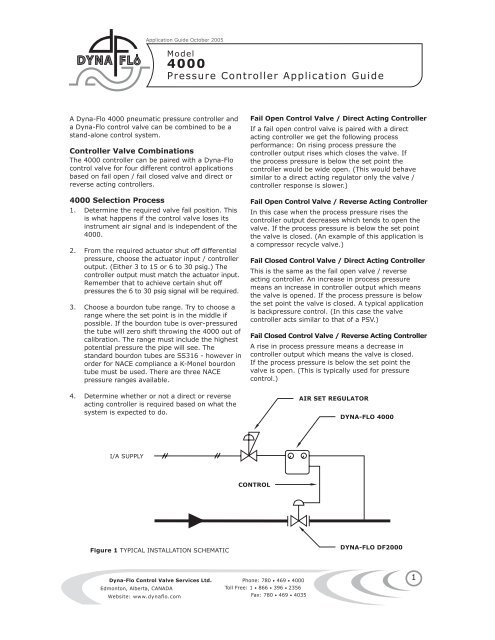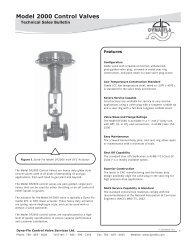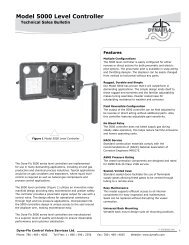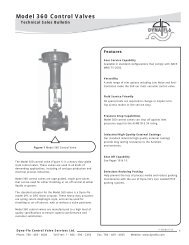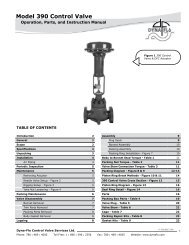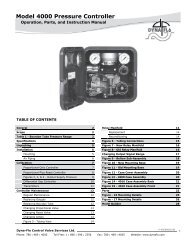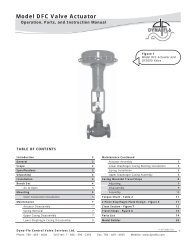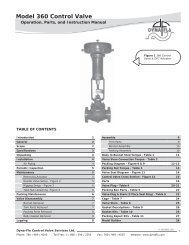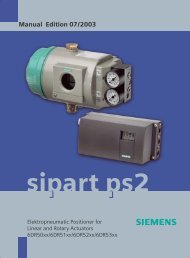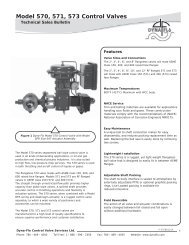view faq & application guide (pdf) - dyna-flo control valves
view faq & application guide (pdf) - dyna-flo control valves
view faq & application guide (pdf) - dyna-flo control valves
Create successful ePaper yourself
Turn your PDF publications into a flip-book with our unique Google optimized e-Paper software.
Application Guide October 2005<br />
Model<br />
4000<br />
Pressure Controller Application Guide<br />
A Dyna-Flo 4000 pneumatic pressure <strong>control</strong>ler and<br />
a Dyna-Flo <strong>control</strong> valve can be combined to be a<br />
stand-alone <strong>control</strong> system.<br />
Controller Valve Combinations<br />
The 4000 <strong>control</strong>ler can be paired with a Dyna-Flo<br />
<strong>control</strong> valve for four different <strong>control</strong> <strong>application</strong>s<br />
based on fail open / fail closed valve and direct or<br />
reverse acting <strong>control</strong>lers.<br />
4000 Selection Process<br />
1. Determine the required valve fail position. This<br />
is what happens if the <strong>control</strong> valve loses its<br />
instrument air signal and is independent of the<br />
4000.<br />
2. From the required actuator shut off differential<br />
pressure, choose the actuator input / <strong>control</strong>ler<br />
output. (Either 3 to 15 or 6 to 30 psig.) The<br />
<strong>control</strong>ler output must match the actuator input.<br />
Remember that to achieve certain shut off<br />
pressures the 6 to 30 psig signal will be required.<br />
3. Choose a bourdon tube range. Try to choose a<br />
range where the set point is in the middle if<br />
possible. If the bourdon tube is over-pressured<br />
the tube will zero shift throwing the 4000 out of<br />
calibration. The range must include the highest<br />
potential pressure the pipe will see. The<br />
standard bourdon tubes are SS316 - however in<br />
order for NACE compliance a K-Monel bourdon<br />
tube must be used. There are three NACE<br />
pressure ranges available.<br />
4. Determine whether or not a direct or reverse<br />
acting <strong>control</strong>ler is required based on what the<br />
system is expected to do.<br />
Fail Open Control Valve / Direct Acting Controller<br />
If a fail open <strong>control</strong> valve is paired with a direct<br />
acting <strong>control</strong>ler we get the following process<br />
performance: On rising process pressure the<br />
<strong>control</strong>ler output rises which closes the valve. If<br />
the process pressure is below the set point the<br />
<strong>control</strong>ler would be wide open. (This would behave<br />
similar to a direct acting regulator only the valve /<br />
<strong>control</strong>ler response is slower.)<br />
Fail Open Control Valve / Reverse Acting Controller<br />
In this case when the process pressure rises the<br />
<strong>control</strong>ler output decreases which tends to open the<br />
valve. If the process pressure is below the set point<br />
the valve is closed. (An example of this <strong>application</strong> is<br />
a compressor recycle valve.)<br />
Fail Closed Control Valve / Direct Acting Controller<br />
This is the same as the fail open valve / reverse<br />
acting <strong>control</strong>ler. An increase in process pressure<br />
means an increase in <strong>control</strong>ler output which means<br />
the valve is opened. If the process pressure is below<br />
the set point the valve is closed. A typical <strong>application</strong><br />
is backpressure <strong>control</strong>. (In this case the valve<br />
<strong>control</strong>ler acts similar to that of a PSV.)<br />
Fail Closed Control Valve / Reverse Acting Controller<br />
A rise in process pressure means a decrease in<br />
<strong>control</strong>ler output which means the valve is closed.<br />
If the process pressure is below the set point the<br />
valve is open. (This is typically used for pressure<br />
<strong>control</strong>.)<br />
AIR SET REGULATOR<br />
DYNA-FLO 4000<br />
I/A SUPPLY<br />
CONTROL<br />
Figure 1 TYPICAL INSTALLATION SCHEMATIC<br />
DYNA-FLO DF2000<br />
Dyna-Flo Control Valve Services Ltd.<br />
Edmonton, Alberta, CANADA<br />
Website: www.<strong>dyna</strong><strong>flo</strong>.com<br />
Phone: 780 • 469 • 4000<br />
Toll Free: 1 • 866 • 396 • 2356<br />
Fax: 780 • 469 • 4035<br />
1
Application Guide October 2005<br />
Model<br />
4000<br />
Pressure Controller Application Guide<br />
Valve Controller Process Increases Process Below Air Signal<br />
Orientation Action Valve Tries To Set Point Valve Is Fails Valve<br />
Fail Open Direct Close Open Opens<br />
Fail Open Reverse Open Closed Opens<br />
Fail Closed Direct Open Closed Closes<br />
Fail Closed Reverse Close Open Closes<br />
FAQ’s<br />
What is the <strong>control</strong> range of the bourdon<br />
tubes?<br />
The <strong>control</strong> range is 6% to 100% of the range. This<br />
means a 1500 psig tube can <strong>control</strong> anywhere from<br />
90 psig to 1500 psig.<br />
What happens if the process pressure<br />
increases to more than the tube rating?<br />
The bourdon tubes have a particular range in which<br />
they properly operate. If a tube is stretched past its<br />
operating point the <strong>control</strong>ler will operate with more<br />
error. To avoid this zero shift a mechanical travel<br />
stop can be used.<br />
What is the burst pressure for the<br />
various bourdon tubes?<br />
TUBE RATING<br />
BURST PRESSURE<br />
0-30 psig 1175 psig<br />
0-60 psig 1400 psig<br />
0-100 psig 1750 psig<br />
0-200 psig 2200 psig<br />
0-300 psig 2550 psig<br />
0-600 psig 2650 psig<br />
0-1000 psig 2950 psig<br />
0-1500 psig 10300 psig<br />
0-3000 psig 13200 psig<br />
0-5000 psig 17600 psig<br />
I want to <strong>control</strong> at 40 psig but the line<br />
might pressure up to 600 ANSI. What<br />
should I use?<br />
A 0 to 1500 psig tube can only <strong>control</strong> to 90 psig -<br />
and it is preferable to <strong>control</strong> in the middle of the<br />
range - not at the end points. A 60 psig tube is<br />
only rated to 1400 psig so use a 100 psig tube<br />
rated to 1750 psig. A mechanical travel stop<br />
should be installed to prevent the 4000 from<br />
seeing any zero shift.<br />
How can the 4000 be mounted?<br />
The 4000 <strong>control</strong>ler can be either mounted on the<br />
<strong>control</strong> valve or remote mounted in a panel, on a<br />
wall or on a pipe stand. Typically an air set regulator<br />
is required.<br />
Can I re-use an existing 4000 or existing<br />
<strong>control</strong> valve?<br />
When matching a 4000 and <strong>control</strong> valve it is<br />
important to make sure that the output from the<br />
<strong>control</strong>ler matches that of the <strong>control</strong> valve input.<br />
Most <strong>control</strong> <strong>valves</strong> are either 3 to 15 psig or 6 to<br />
30 psig - the 4000 output can be either. The output<br />
range does impact the amount of shut-off available<br />
to the actuator. Dyna-Flo will assume a 6 to 30<br />
output, as this is the more common.<br />
Can I use wet natural gas as instrument<br />
gas?<br />
No. We recommend dry natural gas. If wet gas is<br />
used there is the possibility the <strong>control</strong>ler will stop<br />
working as the orifices could clog.<br />
Is the action field reversible?<br />
The <strong>control</strong>ler action (direct or reverse) is easily<br />
field reversible - however the <strong>control</strong>ler does need<br />
to be re-calibrated.<br />
Can I field change from a 6-30 psig to 3-<br />
15 psig <strong>control</strong>ler output?<br />
Yes, the change is easy. However the <strong>control</strong>ler<br />
must be re calibrated.<br />
We are using another manufacturers<br />
pressure <strong>control</strong>ler. Will I have to buy<br />
two sets of parts?<br />
No. The 4000 parts are interchangeable with a<br />
FISHER* 4150/4160 <strong>control</strong>ler.<br />
* FISHER is a registered trademark of FISHER Controls International. FISHER Controls International is not associated or affiliated with<br />
Dyna-Flo in any way, nor has FISHER sponsored, approved, or otherwise re<strong>view</strong>ed any products made, sold, or re-manufactured by Dyna-Flo.<br />
Dyna-Flo Control Valve Services Ltd.<br />
Edmonton, Alberta, CANADA<br />
Website: www.<strong>dyna</strong><strong>flo</strong>.com<br />
Phone: 780 • 469 • 4000<br />
Toll Free: 1 • 866 • 396 • 2356<br />
Fax: 780 • 469 • 4035<br />
2


